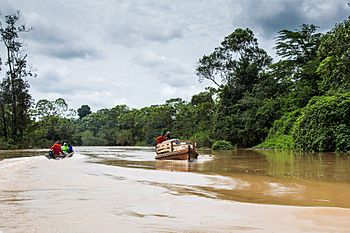Acre River facts for kids
Quick facts for kids Acre River |
|
|---|---|

Acre River as seen near Xapuri, Acre, Brazil
|
|

Map of the Amazon Basin with the Acre River highlighted
|
|
| Countries |
|
| Physical characteristics | |
| River mouth | Purus River |
| Length | 680 km (420 mi) |
The Acre River is a long river in South America. It's about 680 kilometers (420 miles) long. People who live near the river sometimes call it Rio Acre. In the local Iñapari language, it's known as Aquiry.
Contents
Acre River: A Journey Through South America
The Acre River is an important waterway in central South America. It flows through three different countries. These countries are Peru, Brazil, and Bolivia.
Where Does the Acre River Flow?
The Acre River starts its journey in Peru. From there, it flows towards the northeast. For some parts of its path, it forms a natural border. It helps to mark the edge between Peru and Brazil. Later, it also forms part of the border between Bolivia and Brazil.
The river then enters the Brazilian states of Acre and Amazonas. Finally, it joins another big river called the Purus River. This meeting point is near a place called Boca do Acre.
Why Was the Acre River Important?
The Acre River has always been a key route for travel. It is easy to travel by boat on the river for about 480 kilometers (300 miles). This is from its mouth all the way to the Xapuri River. During the wet season, which is from January to May, boats can go even further.
In the late 1800s, the river became super important. People discovered many rubber trees in the forests nearby. Rubber was a very valuable material back then. The Acre River was used to transport the rubber to big markets. These markets were in cities like Iquitos, Manaus, and Pará.
The Rubber Boom and Border Changes
Between 1870 and 1878, people from Peru settled in the Acre region. But in the next ten years, many Brazilian rubber collectors moved in. This was during a time known as the 'rubber boom'.
In 1899, the government of Bolivia set up a special office. This office was at Puerto Alonso, right on the Acre River. Its job was to collect taxes on the rubber that was being sent out. This caused a disagreement with the Brazilian settlers. It also led to a border dispute between Bolivia and Brazil.
In July 1899, some people in the Acre region declared they wanted to be independent. They even tried to create their own republic. But by March of the next year, Brazil took control again. More problems followed. Brazil eventually sent its military to Puerto Alonso.
The border disagreement was finally solved in Petropolis on November 17, 1903. Brazil bought the rubber-producing land from Bolivia. This land was south of about the ninth parallel.
Protecting the Acre River
Today, there's a special protected area called the Rio Acre Ecological Station. It is located in Brazil, in the state of Acre. This area includes parts of the Amazon forest. It is important because it helps to protect where the Acre River begins.
See also
 In Spanish: Río Acre para niños
In Spanish: Río Acre para niños

